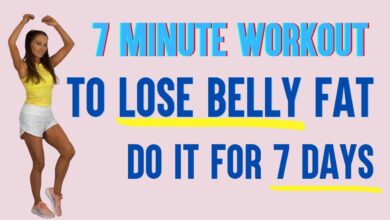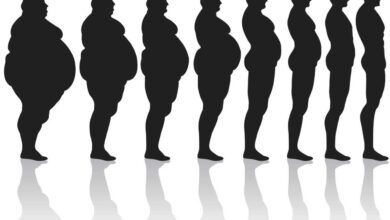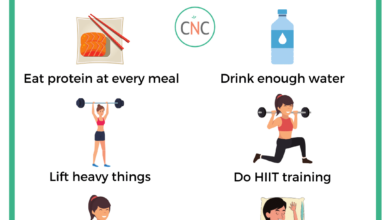
Top Myths About Fitness: Debunking Common Misconceptions
Top myths about fitness: we’ve all heard them. From the idea that spot reduction is possible to the belief that you need expensive equipment to get in shape, these misconceptions can hold us back from achieving our fitness goals. But the truth is, there’s a lot of misinformation out there, and it’s time to set the record straight.
This blog post will debunk some of the most common myths about fitness, providing you with the facts you need to make informed decisions about your health and well-being. We’ll explore everything from the importance of strength training to the dangers of restrictive diets, and we’ll provide practical tips and advice to help you reach your fitness goals in a safe and sustainable way.
Spot Reduction is a Myth

It’s a common misconception that you can target specific areas of your body for fat loss, like doing endless crunches to get a six-pack. While you can build muscle in specific areas, you can’t burn fat solely in those spots.
How Fat Loss Works, Top myths about fitness
Fat loss is a process that occurs throughout the entire body, not just in one area. When you lose weight, your body burns fat from various areas, depending on your genetics and how much fat you have stored in different areas.
Role of Calorie Deficit
The fundamental principle of fat loss is creating a calorie deficit. This means burning more calories than you consume.
To lose weight, you need to consume fewer calories than you burn.
One of the biggest fitness myths I used to believe was that you needed to push yourself to exhaustion every workout. Turns out, your body needs time to recover, and that’s where your post-workout music can play a big role.
Choosing the right tunes can actually help you relax and recharge, which is just as important for building strength and endurance as the workout itself. So, next time you’re feeling burned out, try a calming playlist and see the difference it makes!
A calorie deficit can be achieved through a combination of diet and exercise.
Role of Exercise
While exercise doesn’t directly target specific areas for fat loss, it plays a crucial role in overall fat loss. Exercise helps you burn more calories and build muscle, which increases your metabolism and helps you burn more calories even when you’re at rest.
Effective Exercises for Different Muscle Groups
Here are some examples of effective exercises for different muscle groups:
Upper Body
- Push-ups:Work your chest, shoulders, and triceps.
- Pull-ups:Target your back, biceps, and forearms.
- Dumbbell rows:Build your back and biceps.
- Overhead press:Strengthen your shoulders and triceps.
Lower Body
- Squats:Work your quads, glutes, and hamstrings.
- Lunges:Target your quads, glutes, and hamstrings.
- Deadlifts:Engage your entire lower body, including your back, glutes, and hamstrings.
- Calf raises:Strengthen your calves.
Core
- Plank:Engage your entire core, including your abs, obliques, and lower back.
- Crunches:Work your upper abs.
- Russian twists:Target your obliques.
- Leg raises:Strengthen your lower abs.
Cardio is the Only Way to Lose Weight

It’s a common misconception that cardio is the only way to shed pounds. While cardio is essential for overall health and fitness, strength training plays a crucial role in weight loss and can actually be more effective than cardio alone.
Strength Training for Weight Loss
Strength training is a type of exercise that involves using resistance to build muscle mass. It’s not just about getting bulky; strength training offers a wide range of benefits for weight loss and overall health. Here’s how strength training contributes to weight loss:
- Increased Metabolism:Building muscle through strength training boosts your metabolism, which is the rate at which your body burns calories. More muscle mass means your body burns more calories even at rest.
- Improved Body Composition:Strength training helps you build muscle while simultaneously reducing fat mass. This leads to a more favorable body composition, which is a better indicator of health than just weight alone.
- Increased Strength and Endurance:Stronger muscles make everyday activities easier, and you’ll have more energy for other forms of exercise, including cardio.
- Enhanced Bone Density:Strength training strengthens bones, reducing the risk of osteoporosis and fractures, especially important as we age.
- Improved Insulin Sensitivity:Strength training can help improve your body’s response to insulin, which helps regulate blood sugar levels and can reduce the risk of type 2 diabetes.
Cardio vs. Strength Training for Weight Loss
Both cardio and strength training are valuable for weight loss, but they work in different ways.
One of the biggest myths about fitness is that you have to be constantly losing weight to see results. In reality, aiming to maintain weight can actually help fat loss goals by creating a sustainable lifestyle that you can stick with long-term.
Check out this article, why aiming to maintain weight can actually help fat loss goals , to learn more about this concept. Ultimately, consistent effort and a balanced approach are key to achieving lasting fitness success, not just quick fixes or drastic weight loss.
- Cardio:Primarily burns calories during the workout, improving cardiovascular health, and increasing endurance.
- Strength Training:Primarily builds muscle mass, boosting metabolism and leading to increased calorie expenditure even at rest.
The most effective approach for weight loss combines both cardio and strength training.
“For long-term weight management, a combination of cardio and strength training is ideal.”
American Council on Exercise
For optimal results, aim for at least two strength training sessions per week, focusing on major muscle groups. Incorporate cardio activities you enjoy, such as running, swimming, or cycling, for at least 30 minutes most days of the week.
All Calories Are Created Equal: Top Myths About Fitness
It’s a common misconception that all calories are the same, regardless of their source. This belief often leads people to focus solely on calorie restriction without considering the quality of their food choices. However, the truth is that different foods impact our bodies and our overall health in different ways.
Macronutrients and Their Impact on Satiety and Metabolism
The three macronutrients—carbohydrates, protein, and fat—provide our bodies with energy. While they all contribute to calorie intake, they differ in their impact on satiety, metabolism, and overall health.
- Carbohydratesare the body’s primary source of energy. They are broken down into glucose, which is used by cells for fuel. Carbohydrates can be simple (sugars) or complex (starches and fiber). Simple carbohydrates are quickly digested and absorbed, leading to a rapid rise in blood sugar levels, followed by a crash.
One of the biggest myths about fitness is that you need to push yourself to the limit every single day. In reality, recovery days are just as important as your workouts. In fact, 5 great things about recovery days can help you avoid injury, improve your performance, and make your workouts more enjoyable.
So don’t be afraid to take a break, your body will thank you for it!
Complex carbohydrates, on the other hand, are digested more slowly, providing a sustained release of energy and promoting feelings of fullness.
- Proteinis essential for building and repairing tissues, producing enzymes and hormones, and supporting immune function. It also plays a role in regulating blood sugar levels and promoting satiety. Protein is digested more slowly than carbohydrates, making it a more filling macronutrient.
It also has a higher thermic effect, meaning that the body burns more calories digesting and processing protein than it does carbohydrates or fat.
- Fatis a concentrated source of energy and plays a crucial role in hormone production, cell function, and nutrient absorption. However, not all fats are created equal. Saturated and trans fats can raise cholesterol levels and increase the risk of heart disease.
Unsaturated fats, on the other hand, are beneficial for heart health and can help lower cholesterol levels. Fat is digested slowly, providing a feeling of fullness and promoting satiety.
Importance of Choosing Nutrient-Dense Foods Over Calorie-Dense Foods
Nutrient-dense foods are rich in vitamins, minerals, and other essential nutrients, while calorie-dense foods are high in calories but low in nutrients. Choosing nutrient-dense foods over calorie-dense foods is crucial for optimal health and weight management.
A nutrient-rich diet can help you feel fuller for longer, manage your weight, and reduce your risk of chronic diseases.
Examples of Healthy Meal Plans
Here are some examples of healthy meal plans that prioritize nutrient-rich foods:
- Breakfast: Oatmeal with berries and nuts, Greek yogurt with fruit and granola, or a whole-wheat toast with avocado and egg.
- Lunch: Salad with grilled chicken or fish, lentil soup with whole-grain bread, or a veggie wrap with hummus.
- Dinner: Salmon with roasted vegetables, chicken stir-fry with brown rice, or lentil stew with whole-grain couscous.
You Need to Starve Yourself to Lose Weight
This is a common misconception, and it’s one that can be incredibly harmful. While it’s true that creating a calorie deficit is essential for weight loss, starving yourself is not the answer. Restrictive diets are often unsustainable and can lead to a variety of health problems.
The Dangers of Restrictive Diets
Restrictive diets are often characterized by severely limiting calories, eliminating entire food groups, or focusing on a single type of food. While these diets may lead to initial weight loss, they are not a sustainable long-term solution. Here’s why:
- Nutrient deficiencies:Restrictive diets often lack essential nutrients, which can lead to fatigue, hair loss, weakened immunity, and other health problems.
- Metabolic slowdown:When you severely restrict calories, your body goes into “starvation mode,” slowing down your metabolism to conserve energy. This makes it harder to lose weight and can lead to weight regain once you start eating normally again.
- Increased risk of eating disorders:Restrictive diets can trigger unhealthy eating habits and contribute to the development of eating disorders.
- Psychological distress:Feeling deprived and constantly thinking about food can lead to stress, anxiety, and depression.
The Importance of Sustainable Eating Habits
The key to successful weight loss is to adopt sustainable eating habits that you can maintain for the long term. This means focusing on a balanced diet that provides all the nutrients your body needs, while also creating a calorie deficit.
Mindful Eating and Portion Control
Mindful eating is a practice that involves paying attention to your body’s hunger and fullness cues. This helps you to eat only when you are truly hungry and to stop eating when you are satisfied. Portion control is another important aspect of sustainable weight loss.
It’s about being mindful of the amount of food you are consuming and making sure you are not overeating.
Healthy and Satisfying Meal Options
There are many healthy and satisfying meal options that can support weight loss. Here are a few examples:
- Lean protein:Chicken, fish, beans, lentils, tofu, and eggs are excellent sources of protein that can help you feel full and satisfied.
- Whole grains:Brown rice, quinoa, oats, and whole-wheat bread are good sources of fiber, which helps regulate digestion and keeps you feeling full.
- Fruits and vegetables:These are low in calories and packed with vitamins, minerals, and fiber.
- Healthy fats:Avocado, nuts, seeds, and olive oil provide essential fatty acids and can help you feel satisfied.
Ending Remarks
So, there you have it. The truth is, fitness is a journey, not a destination. It’s about finding what works best for you and making sustainable changes to your lifestyle. Don’t be discouraged by myths or misinformation – embrace the facts, stay consistent, and celebrate your progress along the way.
You’ve got this!






